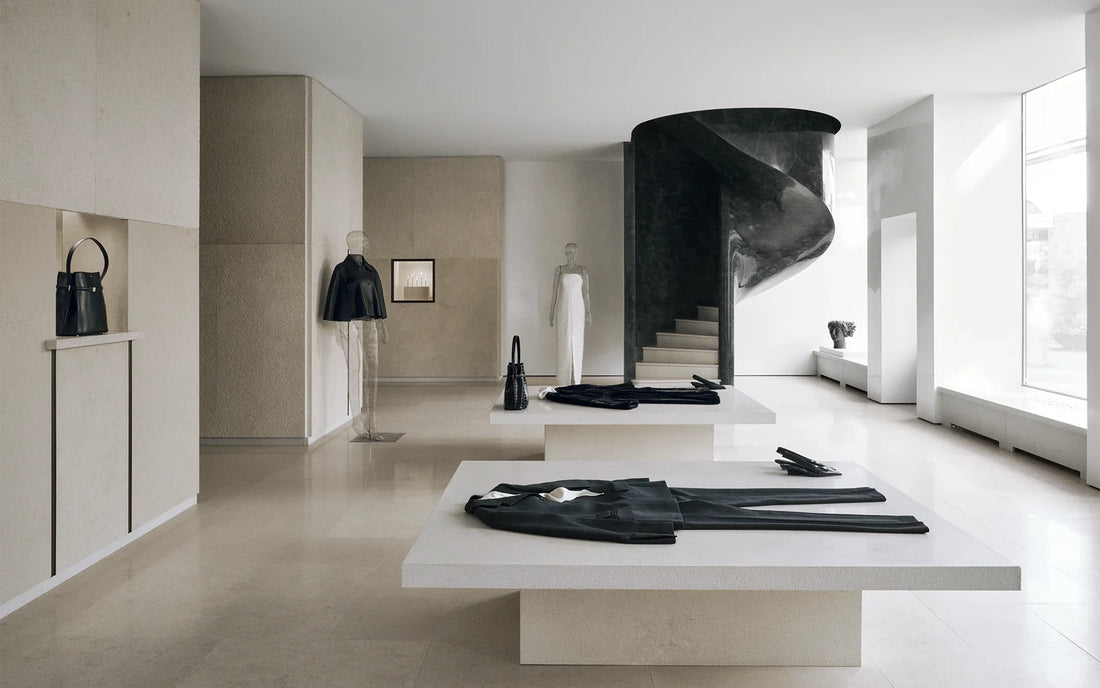
What Is Contemporary Style?
Share
Contemporary style is a fascinating and ever-evolving design movement that has shaped everything from fashion to interior design and architecture. Known for its clean lines, minimalist silhouettes, and a dynamic blend of modern aesthetics, contemporary style is often described as being "of the moment." But what exactly does it mean, and how did it come to be?
In this in-depth article, we’ll explore the origins of contemporary style, its key silhouettes, influential figures, important colour schemes, and why it's a significant design movement in today's world. By the end, you’ll have a comprehensive understanding of contemporary style and what makes it such a versatile and influential design philosophy.
Origins of Contemporary Style
Contemporary style emerged in the latter half of the 20th century, evolving as a reaction to the stark minimalism and rigid rules of Modernism. While the two terms are often used interchangeably, it’s important to distinguish between them. Modernism is a defined architectural and design movement rooted in the early to mid-20th century, whereas contemporary design continually evolves based on current trends.
Postmodernism Influence:
The late 1970s and early 1980s saw the rise of Postmodernism, which rejected Modernism's austere approach to design and embraced a more eclectic, playful, and human-centric aesthetic. While contemporary style borrowed some principles from Modernism—like simplicity and functionality—it began incorporating elements of warmth, softness, and organic forms that were largely absent from modernist designs.
Key Characteristics of Contemporary Silhouettes
In fashion, furniture design, or architecture, the contemporary style tends to focus on clean, simple lines and a minimalist approach to form and function. However, contemporary silhouettes are never cold or harsh—they often feature a blend of organic, rounded shapes with linear, geometric elements. Below are some key silhouettes that define contemporary style across various mediums:
- Clean Lines: Whether in fashion or architecture, contemporary designs prioritise uncluttered, simple forms. This can be seen in furniture with straight edges or sleek, tailored clothing that emphasises form without excessive ornamentation.
- Curved Elements: To soften the starkness of minimalism, contemporary designs often incorporate gentle curves. In fashion, this could translate into garments that drape elegantly over the body. In architecture, curved walls or rounded corners add warmth and fluidity to spaces.
- Layering: In contemporary fashion, layering plays a key role in creating dynamic, interesting silhouettes. This can mean pairing structured pieces with flowing fabrics or combining different textures to add depth to an outfit.
- Focus on Comfort and Functionality: While contemporary design looks sleek, comfort and usability are always prioritised. For instance, contemporary furniture may appear sculptural but is designed with ergonomics in mind. Likewise, contemporary clothing is as wearable as it is aesthetically pleasing.

Influential Figures in Contemporary Style
Numerous designers, architects, and fashion icons have played pivotal roles in shaping contemporary style. Here are a few key names who have left an indelible mark on the movement:
1. Zaha Hadid (1950–2016): Zaha Hadid, an Iraqi-British architect, was known for her fluid and futuristic designs, which often featured sweeping curves and sharp angles. Hadid’s works embody the dynamic and ever-evolving nature of contemporary architecture, blending high-tech design with organic, flowing forms. Her works like the Heydar Aliyev Center in Baku and the London Aquatics Centre are iconic examples of contemporary architecture.
2. Calvin Klein: In the world of fashion, Calvin Klein is often credited with bringing a minimalist and contemporary sensibility to the American fashion landscape. Known for his clean lines, neutral palettes, and emphasis on simplicity, Klein helped define contemporary fashion in the late 20th century.
3. Phillippe Starck: A French designer, Starck is celebrated for his wide-ranging contributions to contemporary furniture and product design. Known for creating modern yet playful pieces, his works are often characterised by their sleek, minimalist appearance that combines aesthetics with practicality.
4. Raf Simons: Another key figure in contemporary fashion, Raf Simons, is known for his minimalist yet conceptual designs. Simons often combines traditional tailoring techniques with avant-garde elements, pushing the boundaries of contemporary menswear.
5. Tadao Ando: A Japanese architect, Tadao Ando’s work is the epitome of contemporary architecture. His designs often feature raw concrete, large open spaces, and a focus on natural light. His ability to merge the built environment with nature has influenced many architects working within the contemporary movement.
Colours in Contemporary Style
Contemporary style is largely defined by its colour palette, which tends to lean toward neutral tones with occasional pops of bold colour. The emphasis is often on balance and restraint, which helps create a sophisticated and polished look. Below are some of the key colours you’ll find in contemporary designs:
- Neutrals: Shades of white, black, grey, and beige form the foundation of contemporary style. These neutral tones allow other design elements, like texture and shape, to take centre stage.
- Bold Accents: Contemporary design is not afraid of a pop of colour, especially when used sparingly. Jewel tones like emerald green, royal blue, or deep burgundy are often used as accent colours in fashion, interiors, or product design.
- Monochrome Palettes: Black and white is a common colour scheme in contemporary style, particularly in interiors. The sharp contrast between these two colours creates a striking, modern look.
- Metallics: In both fashion and interior design, metallics like chrome, steel, or brass are often used to add a sense of modernity and sleekness. These elements can be found in anything from contemporary jewellery to light fixtures and hardware.

The Importance of Contemporary Style in Today’s World
Contemporary style is more than just an aesthetic, it's a reflection of the current cultural, social, and technological landscape. Here’s why it remains a significant design movement today:
- Adaptability: One of the key characteristics of contemporary style is its ability to adapt and evolve. Unlike other design movements tied to a specific historical period, contemporary style is always in flux, allowing it to remain relevant as trends change.
- Sustainability: As the world becomes more eco-conscious, contemporary design has embraced sustainable practices, particularly in architecture and fashion. The use of eco-friendly materials, energy-efficient technology, and sustainable manufacturing processes is often a hallmark of contemporary design today.
- Functionality: Contemporary style prioritises functionality and comfort, which makes it particularly well-suited for today’s fast-paced, technology-driven world. Whether it’s ergonomic furniture or wearable fashion, contemporary design seeks to make life easier and more efficient without sacrificing aesthetics.
- Inclusivity: Contemporary design is often associated with inclusivity and accessibility. In fashion, for example, contemporary brands are more likely to offer a diverse range of sizes and cater to different body types. In architecture, contemporary designs aim to create spaces that are accessible to everyone, regardless of physical ability.
Contemporary Style in Fashion
Fashion is one of the most accessible expressions of contemporary style. Over the decades, contemporary fashion has evolved to reflect societal changes, technological advancements, and cultural shifts. Here are some defining characteristics of contemporary fashion:
- Minimalism Meets Boldness: While minimalism plays a large role in contemporary fashion, it’s not about being boring. Designers often mix minimalistic pieces with bold accessories or avant-garde elements, creating a striking balance.
- Sustainability and Slow Fashion: Many contemporary fashion designers and brands are embracing sustainable fashion practices, using eco-friendly materials, reducing waste, and creating timeless pieces designed to last, thus contributing to the slow fashion movement.
- High-Low Mix: Contemporary fashion often sees a mix of high-end and low-end pieces. This "high-low" approach allows people to express their personal style without breaking the bank, blending designer items with more affordable, everyday wear.

Contemporary Style in Interior Design
Contemporary style in interior design is all about creating spaces that feel modern, clean, and functional while still being warm and inviting. Here are some of the key elements of contemporary interior design:
- Open Floor Plans: Contemporary interiors often feature open layouts that allow for flexibility and fluid movement between spaces. This creates a sense of airiness and space.
- Natural Materials: While synthetic materials have their place, contemporary interiors often incorporate natural materials like wood, stone, and metal. These materials add texture and warmth to otherwise minimalist spaces.
- Statement Lighting: Lighting is a crucial element in contemporary interiors, often serving as a focal point. Pendant lights, floor lamps, and sconces with clean, geometric designs are popular choices.
- Bold Accents: While the overall palette tends to be neutral, contemporary interiors often include bold accents like brightly coloured artwork, statement furniture, or eye-catching rugs to add personality to the space.
Why Contemporary Style Matters Today
Contemporary style is significant because it reflects the way we live in the modern world. Its emphasis on functionality, comfort, and sustainability aligns with current societal values, while its adaptability allows it to stay relevant as trends and technologies change. Moreover, contemporary design is inclusive and accessible, making it a style that anyone can adopt, regardless of budget or lifestyle.
Contemporary style is more than just a design trend—it's a constantly evolving movement
--
Shop the best contemporary petite clothing brand for shorter women here at the House of Arti:
Shop your garment size (XS, S, M, L, XL) within your height range on our product pages.
- Extra-Petite: 1.40m - 1.49m | 4f 7.1" - 4f 11"
- Petite: 1.50m - 1.59m | 4f 11.1" - 5f 2.6"
Shop all our styles here --> New Arrivals



